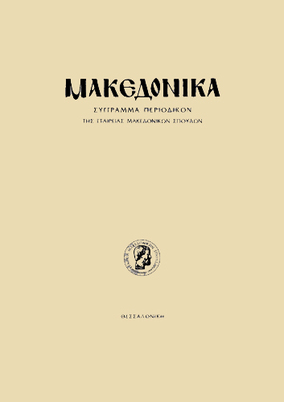Θωράκιο βυζαντινής σαρκοφάγου από τη Ζίχνα
Part of : Μακεδονικά ; Vol.24, 1984, pages 1-35
Issue:
Pages:
1-35
Parallel Title:
Parapet of Byzantine sarcophagus from Zichna
Section Title:
Articles
Abstract:
Opposite the naturally fortified Byzantine settlement of Zichna, at ashort distance from the remains of the walls, on the east side of the enclosure surrounding the small three aisled, wooden roofed basilica of Aghios Ioannis Prodromos (dating from the late years of the Turkish rule), lies broken the external side of a Byzantine sarcophagus (pi. 1-3). The grey lime-stone marble slab has the following dimensions: 0,90x0,70 m, 0,07m depth. It is considered a fragment of a parapet with likely dimensions 1,90x0,70 m (ill. 1). The relief on the surface of the marble slab is low, nevertheless very well designed and executed with great precision. The artist sometimes voluntarily disre gards the summetry, for instance in the foliage which shoots up from the base of the cross (pi. 3). The theme on the slab is fairly well known: a succession of crosses be low arches, supported by delicate columns. The author of the article, having restored in drawing the form of the slab, attempted a comparative examination of the individual elements, such as the archline, the shape of the crosses, the formation of the bases, the foliage, with other corresponding forms of dated reliefs on Byzantine sarcophagi. The sarcophagus of Zichna occupies the first place in a theoretical typological analysis, where the known theme of the archline begins with a genetic form—the arches supported by single columns (ill. 14,1)—continues with the theme of the triumphal arch represented in a row (ill. 14,2) , deve lops into a colonade—where the arches are supported by twin pillars (ill. 14,3)—and finally comes to the beloved theme of the colonade where the twin pillars are closely connected with the well known knot, the mysterious «knot of Hercules» (ill. 14,4). These forms selectively appear in the 11th C until late in the 14th C. Below the arches there are crosses of various types and shapes: with leaves, simple ones, as well as symbolic trees and plants, vine shoots, braids, birds, single ones, twins, facing towards or away from each other, animals and various symbolic themes related to death, Paradise and future life. As a result of the typological and morphological analysis, the date ofthe sarcophagus of Zichna is considered the late 11th or early 12th C, a date which should also be refered to the sculptures related with the old Cathedral of Serres.
Subject:
Subject (LC):
Notes:
856:https://ejournals.epublishing.ekt.gr/index.php/makedonika/article/view/5821, DOI: https://doi.org/10.12681/makedonika.260
Electronic Resources:




